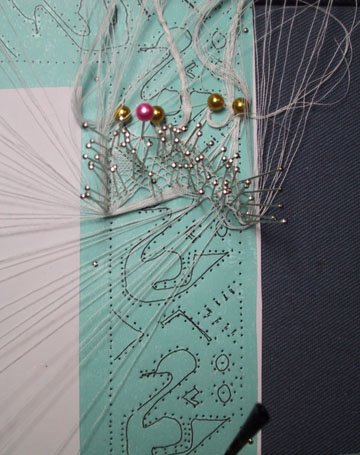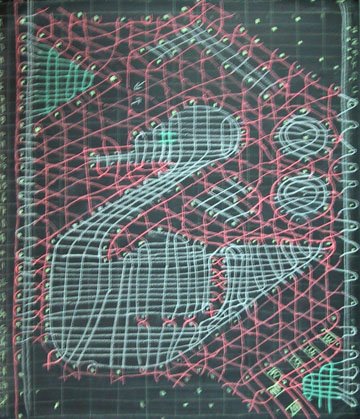Wednesday, July 11, 2007
How do you find other lacemakers?
With a craft that is of limited exposure and interest such as bobbin lace, it's really easy to feel isolated. For those people who are introverts, that's great! For those of us who like to make lace with other people around, it can be difficult to find others who share our passion.
So - where are they? Look for the guilds!
There are a number of organizations that lacemakers belong to.
In the US, the largest group is the International Organization of Lace, Inc. (IOLI), which holds an annual convention. IOLI also has a lace discussion group that you can join. There are many other groups, often one or more in each state, as well as the New England Lace Group (NELG) that covers the New England states of Maine, New Hampshire, Vermont, Massachusetts, Connecticut and Rhode Island.
Here are a few other guilds:
So - where are they? Look for the guilds!
There are a number of organizations that lacemakers belong to.
In the US, the largest group is the International Organization of Lace, Inc. (IOLI), which holds an annual convention. IOLI also has a lace discussion group that you can join. There are many other groups, often one or more in each state, as well as the New England Lace Group (NELG) that covers the New England states of Maine, New Hampshire, Vermont, Massachusetts, Connecticut and Rhode Island.
Here are a few other guilds:
- Canada has a variety of lace guilds, though their websites (if they exist) are difficult to find.
- The British Isles - The Lace Guild
- Ireland - Traditional Lacemakers of Ireland
- Europe - Bobbin Lace European Network (BLEN)
- France - The International Bobbin and Needle Lace Organization (OIDFA)
- Germany - German Lace Guild
- Netherlands - LOKK
- Denmark - Danish Lace Guild
- Australia - Australian Lace Guild
Saturday, April 08, 2006
There are many types of bobbin lace
There was a time when lace was an essential part of fashion. As with many industries, it became highly competitive, which drove the development of different styles of lace most commonly identified with the geographical area in which they were made. For instance, different areas of England each had their own laces, which differed from those made in France, Belgium, Spain, and other locations.
There are also different methods for making bobbin lace. The major distinction is between continuous and discontinuous laces. The continuous laces are made in one continuous strip. Discontinuous laces are made in pieces - for instance, the flowers and leaves may each be made one at a time, and then joined together using a variety of techniques and stitches.
The most common continuous lace is Torchon. Most lacemakers begin with this type, as it is one of the most straightforward to learn. There are many varieties of continuous laces, including Bucks Point, Bedfordshire, Flanders, Binche, Chantilly, Lille, Paris, Valenciennes, Cluny, Chrysanthemum, and others.
Discontinuous laces include Honiton, Rosaline, Duchesse, Milanese, and Bruges flower lace, also known as Bloemwork. The advantage of this kind of lace is that many lacemakers could simultaneously make motifs, and they could then be joined together into a much larger piece.
Now that bobbin lace made by hand is no longer a major fashion industry but is primarily a hobby, lacemakers have the latitude to try their hand at making many different types of lace. The lacemaker can focus on a particular type of lace, or explore all of the possibilities that are available.
There are also different methods for making bobbin lace. The major distinction is between continuous and discontinuous laces. The continuous laces are made in one continuous strip. Discontinuous laces are made in pieces - for instance, the flowers and leaves may each be made one at a time, and then joined together using a variety of techniques and stitches.
The most common continuous lace is Torchon. Most lacemakers begin with this type, as it is one of the most straightforward to learn. There are many varieties of continuous laces, including Bucks Point, Bedfordshire, Flanders, Binche, Chantilly, Lille, Paris, Valenciennes, Cluny, Chrysanthemum, and others.
Discontinuous laces include Honiton, Rosaline, Duchesse, Milanese, and Bruges flower lace, also known as Bloemwork. The advantage of this kind of lace is that many lacemakers could simultaneously make motifs, and they could then be joined together into a much larger piece.
Now that bobbin lace made by hand is no longer a major fashion industry but is primarily a hobby, lacemakers have the latitude to try their hand at making many different types of lace. The lacemaker can focus on a particular type of lace, or explore all of the possibilities that are available.
Sunday, December 04, 2005
So...what do you use bobbin lace for these days?
When you being to wonder what people do with their lace, and envision little doilies all over the furniture and hankies in the drawer, look a little further. There is a wonderful contemporary implementation of lace created by Joep Verhoeven. It's the most beautiful chain link fence I've ever seen.
Of course, there are jewelry interpretations of lace. Gloria Valli's site shows her contemporary jewelry. There are also other "wearables" which the modest might not endeavor to don, but I wouldn't be too surprised to see on a runway model.
There are also people who are doing more classic designs in contemporary jewelry form, such as Susan Lambiris whose site illustrates some of her work. She's working in Flanders, point ground and other lace techniques to create some really beautiful jewelry.
Set your preconceptions aside, and imagine how you might develop your own contemporary interpretation of lace.
Of course, there are jewelry interpretations of lace. Gloria Valli's site shows her contemporary jewelry. There are also other "wearables" which the modest might not endeavor to don, but I wouldn't be too surprised to see on a runway model.
There are also people who are doing more classic designs in contemporary jewelry form, such as Susan Lambiris whose site illustrates some of her work. She's working in Flanders, point ground and other lace techniques to create some really beautiful jewelry.
Set your preconceptions aside, and imagine how you might develop your own contemporary interpretation of lace.
Friday, October 14, 2005
Polychrome de Courseulles
Polychrome de Courseulles is a French lace originating from the Normandy coast in France. It appears around 1896, around the time that Chantilly lace (a black silk lace) was popular.
Polychrome is a silk lace, made with a very fine highly twisted ground thread and multi-colored threads in the decorative areas. The ground thread is usually a blonde color (a natural slightly off-white color), or black. The colored threads are usually not twisted very tightly, and often are strands of multiple colors, creating a combined color.
There are few books available on this lace. Claudette and Michel Bouvot are the primary authors. Dentelles Normandes - Polychrome de Courseulles(2001) is out of print; it is in French with a separate English translation. Polychrome de Courseulles - 9 Modeles (2004) is still available, as is Dentelle Polychrome de Courseulles sur la Route des Dentelles Normandes (the latter by Jean-Claude Brulet).
For anyone who is a fan of color, this is a lovely lace to see and make. Some samples can be seen at http://blondecaen.chez-alice.fr/esom.htm
Polychrome is a silk lace, made with a very fine highly twisted ground thread and multi-colored threads in the decorative areas. The ground thread is usually a blonde color (a natural slightly off-white color), or black. The colored threads are usually not twisted very tightly, and often are strands of multiple colors, creating a combined color.
There are few books available on this lace. Claudette and Michel Bouvot are the primary authors. Dentelles Normandes - Polychrome de Courseulles(2001) is out of print; it is in French with a separate English translation. Polychrome de Courseulles - 9 Modeles (2004) is still available, as is Dentelle Polychrome de Courseulles sur la Route des Dentelles Normandes (the latter by Jean-Claude Brulet).
For anyone who is a fan of color, this is a lovely lace to see and make. Some samples can be seen at http://blondecaen.chez-alice.fr/esom.htm
Monday, June 27, 2005
Making your own block lacemaking pillow
More good stuff from this Australian site http://www.brandis.com.au/craft/lace/block.html - how to make your own block pillow. It's an inexpensive way to get a block pillow to get you started on making lace!
Making paper bobbins for bobbin lace
There are many ways to do things for lacemaking, and this site http://www.brandis.com.au/craft/lace/bobbin.html has an approach for making bobbins from paper, bamboo skewers and beads. Inexpensive, ingenious, and fun for those who like to do such things.
Subscribe to:
Comments (Atom)



